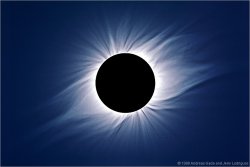Introduction
Interpreting solar X-rays and gamma-rays ultimately requires that we
understand the coronal magnetic field.
The reason for this is that the particles that emit the radiation
RHESSI detects are bound to the field lines.
This is even true for the background coronal plasma, where the
particles have much lower energies, as shown in Figure 1.
The striations,
enhanced in visibility
by judicious radial filtering, have forms that strongly reflect
the presence of a significant magnetic force in the solar corona.
Eclipse photos such as this one have provided convincing qualitative evidence for solar
magnetism long before
Hale demonstrated it spectroscopically in sunspots.
| |
Figure 2:
The solar corona, at solar maximum, seen in an
eclipse
picture.
| |

|
|
This is the first of a projected series of RHESSI science Nuggets
giving short essays on the general subject of coronal magnetism, which is
important for both organizing the source geometry and for
providing the energy and the particle acceleration.
Solar field and terrestrial field
The Earth's magnetic field has the basic form of a dipole, and the
regular pattern of field at the surface of the Earth is stable
enough to guide mariners via use of a
compass.
This dipole is thought to be the result of
dynamo. Currents flowing in the core generate magnetic fields which penetrate the nonconducting
mantle of the earth and diminish rapidly with height.
The solar field, on the other hand, is enormously complicated at the surface
but approximately dipolar at large distances, because the solar wind
flow enforces two
sectors with inward and outward fields associated
with their corresponding polar
coronal holes.
There is no true dipole magnet deep in the interior of the Sun.
Density and |B|, and "beta"
We observe, from large-scale imaging in soft X-rays or the EUV, that the
large-scale coronal structures changes only slowly, except during flares
and CMEs.
The forces acting on the coronal plasma in such a static condition come
from gravity and from the
Maxwell stress tensor.
The former is easy - the hydrostatic law n = noe-h/H
, where h is the height above the photosphere and
H is the scale height, determined by gravity, composition,
and temperature is applicable.
A rough value for the scale height is 0.07 solar radii at the surface, and increases with
height as gravity weakens.
The Maxwell-stress term is also easily understood; the magnetic field
can be described for these purposes as a bundle of
magnetic field lines, each with a tension related to its curvature,
plus an isotropic pressure proportional to B2.
These properties of the magnetic field can be combined and simplified by calculating
the "beta" parameter of plasma physics.
This is the ratio of gas pressure to magnetic pressure, and a kind of
upper limit to the coronal values is shown in Figure 2.
This assumes the field to be strictly dipolar and static; the kink at
2.5 solar radii shows roughly what happens when the solar wind breaks these
assumptions.
In the solar wind, the plasma beta should increase approximately as the distance
from the Sun. When the plasma beta is low, the magnetic forces dominates over gravity and inertia.
This is true everywhere in the corona, except possibly for
prominences.

Figure 2:
The plasma "beta" - the ratio of gas to magnetic pressure - in a radial
cut across the corona.
The dotted lines show, left and right, the photosphere and the
conventional "source surface."
Conclusions
Since the appearance of a
new-cycle sunspot on New Year's (2008), we can expect new X-class flares
and new views of particle acceleration. We therefore need to be as ready
as possible with our understanding of the coronal magnetic field!
See Figure 3 for a view of the new-cycle region and stay tuned for more
information about the coronal magnetic field in future Nuggets.

Figure 3:
The first reasonable sunspot group of Solar Cycle 24.
It even flared!
Note the reversal of polarity and the high latitude of the new region.
Biographical note:
Hugh Hudson is a RHESSI group member at Berkeley.

